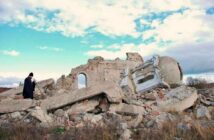
Fr Frank Marangos
Source: OINOS Educational Consulting
by Frank Marangos, D.Min., Ed.D., FCEP
Theodore Roosevelt
The recent polar vortex of 2019 has created historic sub-zero wind chills in the upper Midwest States. Thanks to a trend started in 2016 by Minnesota resident Tom Grotting, the brutal arctic cold has also provided the perfect opportunity for the creation of disembodied ice-pant sculptures, clothes that are soaked, frozen and artfully posed to look as if the wearer has been paralyzed by the severe weather. Consequently, as the wind chill in Minneapolis-Saint Paul plunged to 55 degrees below zero, hundreds of petrified uniforms of bodiless police, mail carriers, hitchhikers, parking attendants, and headless ice-hockey players eerily appeared along the otherwise empty streets of the Twin Cities.
Like the deep freeze that precipitated the sculpting of frozen pants in the upper Midwest section of the United States, a vortex of institutional challenges has unfortunately created the condition of administrative paralysis or, acedia, in many of the nation’s colleges and universities. The word acedia has historically been used by ecclesiastical writers to refer to “the spiritual and physical lethargy which can plague individuals pursuing the eremitic life” (OrthodoxWiki). Referencing King David’s 91st Psalm, the Catholic Education Resource Center personifies the monastic malady, referring to it as the “Noonday Devil . . . the unnamed evil of our times.” In contemporary parlance, acedia is commonly used to describe symptoms of indecision, lethargy, and a sense of hopelessness with what might be perceived as futile activities. Understood in this fashion, acediamay be used to characterize the “frozen pants of inertness” that has unfortunately immobilized many of the nation’s institutions of higher learning.
In his insightful article, Why Good is Still the Enemy of Great for Most Colleges and Universities, James Seidelman, the former Provost of Westminster College and President of the Northwest Commission on Colleges and Universities, laments that many stakeholders in some of the most vulnerable educational institutions in America “are either satisfied with a false sense of security about their competitive positioning or are paralyzed by culture, process, or leadership . . . clinging to the status quo seeing it as a safer, comfortable, and less risky choice.” Seidelman concludes that the reluctance of many small colleges and universities to face difficult realities by advancing innovation and change is generally the result of: (1) falsely seeing themselves as a low-risk institution, (2) misjudging their capacity to make the jump in status to low-risk, and (3) being paralyzed by a lack of leadership, campus politics, or both.
As a consequence of the aforementioned administrative indecision, the National Association of College and University Business Officers (NACUBO) reports that colleges and universities are increasingly unable to raise enough revenue to cover their operating costs. According to the Association, although a tuition discount rate above 35% puts a college in the danger zone, particularly when it is heavily dependent on tuition, the average tuition discount rate for full-time freshmen in 2017–18 was nearly 50%! Education Dive, a leading publication for leaders in the education industry, supports NACUBO’s ill-fated data, testifying that more than 100 for-profit colleges closed in 2018. In addition, 40 mergers and 20 nonprofit private colleges suspended operations during the same time-period.
While generally grim, the most specific sector of vulnerability in higher education is the large number of small institutions, particularly those located in rural areas in the Northeast, where 40% of these colleges and universities have fewer than 1,000 students. Like NACUBO and Education Dive, the 2016 report by Parthenon-EY, Strength in Numbers, warn that 77% of these small colleges and universities exhibited three additional high-risk factors that threaten their survival. These include: (1) high tuition discount rates, (2) dependence on tuition for more than 85% of revenue, and (3) having endowments that cover less than a third of their expenses.
According to a 2018 Moody’s Investors Service Report, private college closures have risen to a rate of about eleven (11) per year. The report was released a few years after Moody’s ominous prediction that closure activity would as much as triple and mergers would double by 2017. Moody’s negative outlook for the higher education industry is based on data that found that 1 in 10 public and private colleges suffer from “acute financial distress” because of falling revenues and weak operating performance. While Moody’s is projecting a future increase in closures to 15 per year, Futurist Magazine anticipates a 50% college failure rate by 2030. The following exhibit shows the number of four-year colleges that have actually closed between 2002-2017.

The good news is that the administrative “pants” of high-risk colleges and universities do not have to freeze in the vortex of acedia. Long-term sustainability can be achieved with appropriate focus and discipline. By utilizing a data-driven and evidence-based approach to culture, process, and change, colleges and universities can transform the vortex of challenges that threaten to freeze their educational mission into windows of opportunities that they can actually initiate and control. What is needed to thaw the current situation is the immediate implementation of a strategy for institutional mobilization.
Mobilization
OINOS Consulting has developed a Decision Mobilization Process (DMP) for strategically re-aligning vision and operations to appropriately reflect an institution’s mission and context, thereby, positioning it to advance a more suitable value-proposition in the higher education sector. The method entails five (5) interrelated steps that engage a select team of administrators, faculty, staff, and trustees to judiciously evaluate and make informed decisions concerning key areas of their respective school’s institutional risk. The team should, additionally, include alumni, major donors, business, and civic leaders. Experienced consultants work with the DMP Team to facilitate progress and the development of an appropriate Mobilization Plan to respond to the vortex of challenges that currently threaten its survival. The following exhibit outlines the DMP methodology that can also be used by a school in a state of temporary closure.
Decision Mobilization Process
- Institutional Audit: Assessment of institutional stress levels according to 20 at-risk indicators.
- Mission/Business Model Evaluation: Re-imaging of existing business model according to emerging best-practice systems used by small, multi-state, and nonprofit college systems.
- : Design of proposed interventions/modifications to the institutional stress levels and mission/business re-imaging needs identified in the previous two steps.
- Mobilization Planning: Development, adoption, and implementation of a strategic mobilization plan.
- Long-Term Resource, Recapitalization, and Advancement Planning: Development of a long-term financial strategy that includes a chart of cash projections, recapitalization of existing debt, and identification of realistic fundraising goals.
Step 1: Institutional Audit
Risk Factors for Small Four-Year Private Educational Institutions
- Institutions with small enrollment are potentially at risk.
- Religious and non-degree granting institutions are now potentially at risk given the financial circumstances.
- Institutions reliant on part-time enrollees are potentially at risk and these institutions could benefit from pushing part-time enrollees into full-time status.
- Rapid expansion of graduate and certificate programs could put an institution at risk if they are not aligned with an intuition’s academic and financial portfolio.
- Tuition per student may be related to financial viability, putting institutions that are inefficient in their tuition setting at risk.
- Institutions with large tuition dependency are potentially at risk.
- Large expenses on interest payments put institutions at risk.
- Large capital expenses without long-term financial stability put institutions at risk.
- Institutions operating with expenses that exceed total revenues are at risk of failure.
- Institutions without strong support from private donations and investment returns put a strain on overall revenue diversity that can put institutions at risk.
Risk Indicators
- Tuition discount is more than 35%.
- Tuition dependency is more than 85%.
- Debt service is more than 10% of the annual operating budget.
- Less than a 1 to 3 ratio between the endowment and the operating budget.
- Student default rate is above 5%.
- Average tuition increase is greater than 8% for 5 years.
- Deferred maintenance at least 40% unfunded.
- Short-term bridge financing required in the final quarter of each fiscal year.
- Less than 10% of the operating budget is dedicated to technology.
- Average annual alumni gift is less than $75.
- Institutional enrollment is 1000 students or lower.
- Conversion yield is 20% behind that of primary competitors.
- Student retention is more than 10% behind that of primary competitors.
- The institution is on probation, warning, or financial watch with a regional accreditor or a specialty degree licensor.
- The majority of faculty have not earned terminal degrees.
- Average age of fulltime faculty is 58 or higher.
- The leadership team averages fewer than 3 years or more than 12 years of service at the institution.
- No complete online program has been developed.
- No new degree or certificate program has been developed for at least 2 years.
- Academic governance and curriculum development systems require more than one year to approve a new degree program.
Step 2: Mission/Business Model Evaluation
Navigating through high-risk environments require building a disciplined administrative culture of persistence and controls. In his noted book, Good to Great (2001), best-selling management author Jim Collins suggests that such a culture is the result of answering three questions: (1) what you do best, (2) what drives your economic engine, and (3) what ignites the passion of your stakeholders. Collins refers to the sum of this “understanding” as the “Hedgehog Concept,” to which high achieving organizations display fanatical devotion to inform their questioning process, dialogue and debate, executive decision-making, and analysis of outcomes.
During the 2nd Step of the Decision Mobilization Process, team members will use Collins’ three questions to identify their respective school’s Hedgehog of differentiation. Revisions, and/or alternatives, for advancing a college/university’s mission should be prudently designed to leverage this understanding. Ideally, the Team will conclude that an institution can maintain its current operating model without major modifications to its existing institution/governance structures. Nevertheless, genuine and candid attempts at meaningful Hedgehog alignment might yield valuable possibilities for creative adaptation.
Serious assessment of an educational institution’s mission will certainly be a sensitive process. Every college mission, however, should be periodically tested for relevance, since the original premise for an institution may not be sustainable in subsequent cultural contexts. Consequently, institutions of higher learning should wisely utilize the current vortex of administrative challenges to synchronize its founding principles with contemporary educational, economic, social, and political realities.
In an interview for Inside Higher Education, Laura Schweitzer, President of Union Graduate College, suggested that college boards should really think about how to best serve their mission. She suggests that at-risk colleges should explore methods of survival that include mergers, absorptions, affiliations and partnerships as viable alternatives to closure. Consequently, apart from identifying their particular Hedgehog of differentiation during this phase of the Decision Mobilization Process, the Team will examine a number of emerging business models for small, multi-state, and nonprofit college systems to determine if the mission of their respective institution of higher learning can be more effectively expedited in another administrative form.
Step 3: Interventions/Modifications
An essential role of the DMP Team is the development of interventions and/or modification to effectively contravene the risk factors and mission/business model weaknesses unmasked during the previous procedures of institutional evaluation. Each intervention/modification should, therefore, include a rationale that reinforces its proposed adoption. In addition to being specific, realistic, and timely, interventions and/or modifications should have unequivocal support of the Team’s representative constituencies.
In his 2014 Forbes Investor article entitled, Top Issues Facing Higher Education, the late John F. Ebersole, former president of Excelsior College, and a visionary educational leader, outlines 10 issues and trends that he believes will impact higher learning in the coming years. Apart from developing interventions/modifications for the results identified during previous procedure, the DMP Team will use the 3rd step in the process to discuss how/if their respective institution of higher learning can leverage its capacities to take advantage of the following sector trends and issues outlined by Ebersole.
- Reauthorization of the Higher Education Act (HEA).
- Quality assurance will become an overarching concern of both state and federal regulators as the role of accreditors is forced more in the direction of regulatory compliance.
- Online education will resume its growth as back-at-work learners see continued need for credentials.
- Competency-Based Education (CBE) will regain momentum.
- Employer-College partnerships can be expected to increase. Degree completion will increase in importance by a growing number of employers, including the federal government.
- Cybersecurity will be the hottest emerging field for new programs. Higher education should provide the credentialed expertise needed.
- Due to an improving economy, public and government attention and a variety of innovations, the cost of degree attainment will begin to stabilize.
- New models of learning will emerge. Text publishers will soon offer “bundled” online media and credit-by-exam resources that will allow for learning and assessment outside of a classroom. Direct assessment, competency-based education (CBE) and credit for prior learning (PLA) are all gaining respectability and acceptance, especially for adult learners.
- The Department of Education will extend financial aid to non-traditional sources of learning.
- Alternative pathways to credit accumulation and new assessors of quality assurance and credit equivalency will be developed. As the unbundling of higher education continues, academic institutions and employers alike are becoming concerned as to what is included in “re-bundled” credentials and who validates.
Step 4: Mobilization
During the 4th step of the Decision Mobilization Process, a comprehensive plan is developed that includes: (a) detailed action steps for each risk area intervention/modification, (b) action step owners, (c) timeline, (d) a realistic budget that provides sufficient funding, (e) metrics for ongoing evaluation, and (f) 10-year capitalization projections. Dashboards and scorecards should also be designed to monitor and adjust the progress of the mobilization plan’s implementation on a regular basis. Sufficient effort should additionally be made to design a robust communications plan to inform students, parents, staff, and local communities. Communication strategies should include direct mailings, press releases, newsletter, website, and community meetings. Announcements should be prepared well in advance and include a summary of the process and reasons leading to the institution’s redesign/reemergence.
In the end, the development of an appropriate Mobilization Plan should be the result of robust engagement and unequivocal support of a cross section of an institution’s constituencies. In order to avoid the reemergence of administrative acedia, once developed, the entire Mobilization Plan should be reviewed, refined, and formally adopted by their school’s respective trustees.
Step 5: Long-Term Resource Planning,Recapitalization and Institutional Advancement
The 5th and final step of the Decision Mobilization Process entails the development of a long-term resources plan that includes recapitalization of existing debt and realistic fundraising goals for institutional advancement. Total capital needs for debt, deferred maintenance, new capital projects, new educational initiatives, extra-curricular activities, and personnel should be identified and projected for the next 10 years. However, only when the Mobilization Team has determined the “uses” for their respective school’s expenses, can resource “sources” to cover those “uses” be targeted. As such, it must here be underscored that, without a long-term resource and recapitalization plan of existing debt, can donor support be appropriately cultivated. Only in this fashion can institutions of higher education be adequately positioned to advance robust change for effectively surviving the institution-threatening vortex of the current higher education environment.
Decisiveness is one of the 14 Leadership Traits of the Marines. Combatants are encouraged by the Corps’ 70% Rule to take decisive action whenever there is 70% confidence in the success of the decision. According to the Rule, it is better to decide quickly on an imperfect plan than to roll out a “perfect” blueprint when it is too late. Waiting for an extra 5-10% degree of clarity only further closes the window of opportunity.
Unfortunately, the vortex of politics, perfectionism, insecurity, and fear of failure oftentimes, paralyze leaders in the solid ice of uncertainty. While analysis, engagement, and constituent support are valuable, leaders of the nation’s institutions of higher education might adhere to the 70% Rule of the Marine Corps and not allow the mobilization of risk-cancelling interventions and educational modification to become the victims of administrative indecision.
In his delightful children’s book, What Was I Scared Of?, Theodor Seuss Geisel, commonly known by his penname Dr. Seuss, depicts a character who frequently encounters an empty pair of green pants in various locations. Terrified by this torso-less article of clothing which he thinks is chasing him, the protagonist finally realizes that the pants are as scared of him as he is of them. After comforting and talking with the torso-less clothing, the two become friends. The beauty of Seuss’ book lies in the simplicity of its message. Overwhelming environments create fear and fear in turn breeds paralysis. Discernment, on the other hand, thaws the chilling effects of emotional paralysis and creates the potential for authentic relationships to emerge.
Like emotional paralysis, organizational acediaoccurs when leaders, institutions, and their constituencies are de-energized by the fear of overwhelming circumstances. Indeed, the path to survival and sustainability for many high-risk educational institutions requires transparency, diligence, and a determined effort to confront the brutal facts of their competitive reality. Administrative acedia should, therefore, not be allowed to cloud their capacity to so effectively engage. The nation’s institutions of higher learning should not allow themselves to be paralyzed in “frozen pants” of inertness but, should be energized by a culture of discernment, authentic relationships, and – above all – decisive mobilization.
In the final analysis, there is nothing to be scared of!



